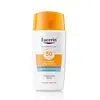What's inside
What's inside
 Key Ingredients
Key Ingredients

 Benefits
Benefits

 Concerns
Concerns

 Ingredients Side-by-side
Ingredients Side-by-side

Water
Skin ConditioningAlcohol Denat.
AntimicrobialC12-15 Alkyl Benzoate
AntimicrobialButyl Methoxydibenzoylmethane
UV AbsorberBis-Ethylhexyloxyphenol Methoxyphenyl Triazine
Skin ConditioningEthylhexyl Triazone
UV AbsorberButylene Glycol Dicaprylate/Dicaprate
EmollientDibutyl Adipate
EmollientDiethylamino Hydroxybenzoyl Hexyl Benzoate
UV FilterPhenylbenzimidazole Sulfonic Acid
UV AbsorberSilica
AbrasiveTapioca Starch
Polyglyceryl-6 Stearate
EmollientSilica Dimethyl Silylate
EmollientGlycerin
HumectantGlycyrrhiza Inflata Root Extract
Skin ConditioningSodium Hyaluronate
HumectantArginine Hcl
Skin ConditioningSodium PCA
HumectantSodium Lactate
BufferingGlycyrrhetinic Acid
Skin ConditioningCetearyl Alcohol
EmollientGlyceryl Stearate
EmollientCopernicia Cerifera Cera
EmollientPolyglyceryl-6 Behenate
Emulsion StabilisingXanthan Gum
EmulsifyingHydroxypropyl Methylcellulose
Emulsion StabilisingSodium Hydroxide
BufferingTrisodium EDTA
Hydroxyacetophenone
AntioxidantPhenoxyethanol
PreservativeParfum
MaskingWater, Alcohol Denat., C12-15 Alkyl Benzoate, Butyl Methoxydibenzoylmethane, Bis-Ethylhexyloxyphenol Methoxyphenyl Triazine, Ethylhexyl Triazone, Butylene Glycol Dicaprylate/Dicaprate, Dibutyl Adipate, Diethylamino Hydroxybenzoyl Hexyl Benzoate, Phenylbenzimidazole Sulfonic Acid, Silica, Tapioca Starch, Polyglyceryl-6 Stearate, Silica Dimethyl Silylate, Glycerin, Glycyrrhiza Inflata Root Extract, Sodium Hyaluronate, Arginine Hcl, Sodium PCA, Sodium Lactate, Glycyrrhetinic Acid, Cetearyl Alcohol, Glyceryl Stearate, Copernicia Cerifera Cera, Polyglyceryl-6 Behenate, Xanthan Gum, Hydroxypropyl Methylcellulose, Sodium Hydroxide, Trisodium EDTA, Hydroxyacetophenone, Phenoxyethanol, Parfum
Water
Skin ConditioningGlycerin
HumectantGlyceryl Glucoside
HumectantSimmondsia Chinensis Seed Oil
EmollientHydrogenated Coco-Glycerides
EmollientCaprylic/Capric Triglyceride
MaskingIsopropyl Palmitate
EmollientSynthetic Beeswax
Emulsion StabilisingGlyceryl Stearate Citrate
EmollientDistarch Phosphate
AbsorbentOctyldodecanol
EmollientPentylene Glycol
Skin ConditioningPanthenol
Skin ConditioningCetyl Alcohol
EmollientStearyl Alcohol
EmollientSodium Hyaluronate
HumectantNiacinamide
SmoothingGlycine
BufferingAlanine
MaskingCarbomer
Emulsion StabilisingTocopheryl Acetate
AntioxidantDimethicone
EmollientCaprylyl Glycol
EmollientPhenoxyethanol
PreservativeWater, Glycerin, Glyceryl Glucoside, Simmondsia Chinensis Seed Oil, Hydrogenated Coco-Glycerides, Caprylic/Capric Triglyceride, Isopropyl Palmitate, Synthetic Beeswax, Glyceryl Stearate Citrate, Distarch Phosphate, Octyldodecanol, Pentylene Glycol, Panthenol, Cetyl Alcohol, Stearyl Alcohol, Sodium Hyaluronate, Niacinamide, Glycine, Alanine, Carbomer, Tocopheryl Acetate, Dimethicone, Caprylyl Glycol, Phenoxyethanol
 Reviews
Reviews

Ingredients Explained
These ingredients are found in both products.
Ingredients higher up in an ingredient list are typically present in a larger amount.
Glycerin is already naturally found in your skin. It helps moisturize and protect your skin.
A study from 2016 found glycerin to be more effective as a humectant than AHAs and hyaluronic acid.
As a humectant, it helps the skin stay hydrated by pulling moisture to your skin. The low molecular weight of glycerin allows it to pull moisture into the deeper layers of your skin.
Hydrated skin improves your skin barrier; Your skin barrier helps protect against irritants and bacteria.
Glycerin has also been found to have antimicrobial and antiviral properties. Due to these properties, glycerin is often used in wound and burn treatments.
In cosmetics, glycerin is usually derived from plants such as soybean or palm. However, it can also be sourced from animals, such as tallow or animal fat.
This ingredient is organic, colorless, odorless, and non-toxic.
Glycerin is the name for this ingredient in American English. British English uses Glycerol/Glycerine.
Learn more about GlycerinPhenoxyethanol is a preservative that has germicide, antimicrobial, and aromatic properties. Studies show that phenoxyethanol can prevent microbial growth. By itself, it has a scent that is similar to that of a rose.
It's often used in formulations along with Caprylyl Glycol to preserve the shelf life of products.
Sodium Hyaluronate is hyaluronic acid's salt form. It is commonly derived from the sodium salt of hyaluronic acid.
Like hyaluronic acid, it is great at holding water and acts as a humectant. This makes it a great skin hydrating ingredient.
Sodium Hyaluronate is naturally occurring in our bodies and is mostly found in eye fluid and joints.
These are some other common types of Hyaluronic Acid:
Learn more about Sodium HyaluronateWater. It's the most common cosmetic ingredient of all. You'll usually see it at the top of ingredient lists, meaning that it makes up the largest part of the product.
So why is it so popular? Water most often acts as a solvent - this means that it helps dissolve other ingredients into the formulation.
You'll also recognize water as that liquid we all need to stay alive. If you see this, drink a glass of water. Stay hydrated!
Learn more about Water